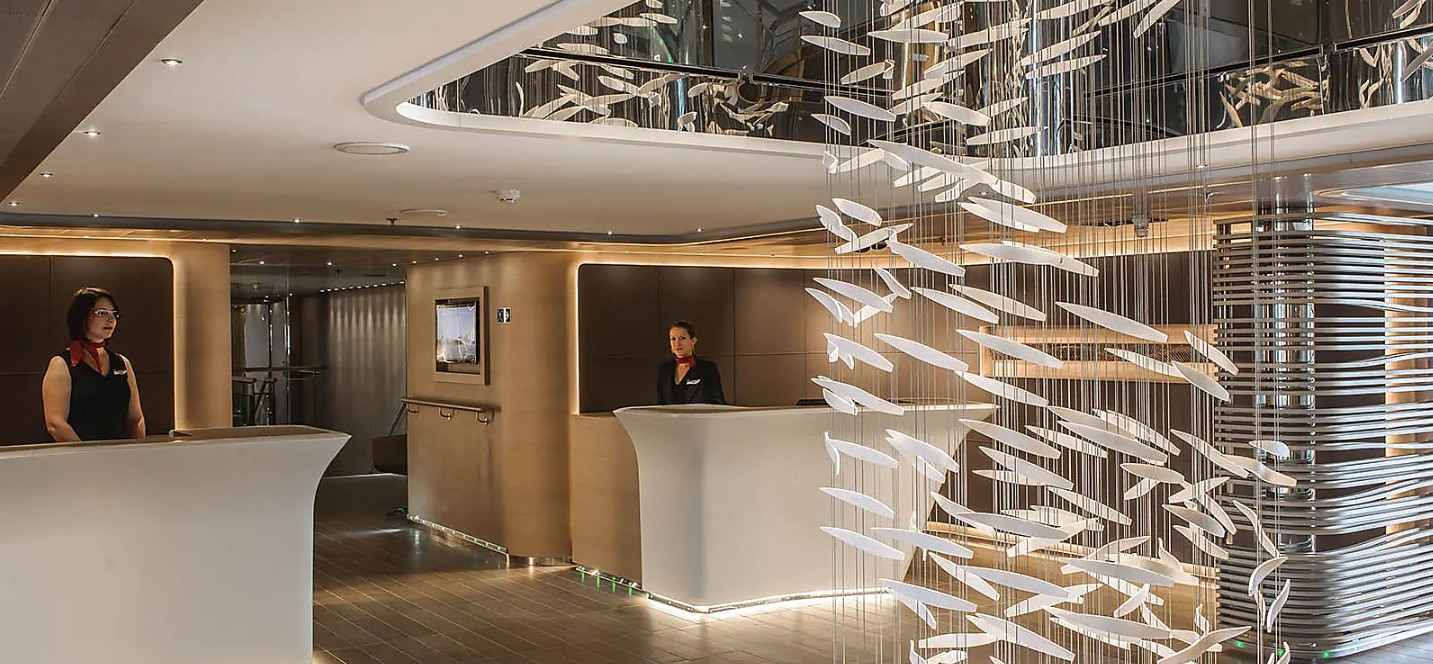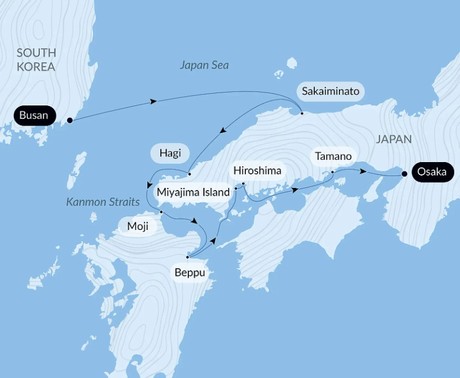Treasures of Japan by Sea – with Smithsonian Journeys
In alliance with Smithsonian Journeys.
This cruise is part of a collection of PONANT voyages that are specially-tailored for English-speaking travelers who want to engage with the world. In addition to the usual elements of the PONANT experience, the listed price for these voyages includes transfers to and from the ship, talks and discussions aboard ship by world class experts, and a shore excursion or activity in each port of call that encourages guests to embrace the sights, sounds, tastes, and smells of the local environment and culture.
Set sail with PONANT aboard Le Soléal for a 9-day cruise to discover the many traditions and emblematic sites of the Land of the Rising Sun.
Your voyage begins in Busan, South Korea. Busan offers a range of experiences during a full day of exploration after an overnight in port: Haedong Yonggungsa Temple, built in 1376 overlooking the sea; the Busan Museum of Art, featuring an outdoor sculpture garden as well as exhibits of contemporary Korean artists; Gyeongju Historic Areas, designated a UNESCO World Heritage site representing the flowering of Silla culture between the 7th and 10th centuries; and a Korean Tea Ceremony at the Hongbeopsa Temple, famous for having the largest Buddha statue in Asia.
Crossing the strait to Japan, the richness from which to choose is immediately apparent in Sakaiminato, where options include Matsue Castle, built entirely of pine in 1611; the Adachi Museum of Art, displaying the great masters of modern Japanese painting and sculpture; a demonstration of the ancient craft of making paper (washi) from tree bark; and Yushien Garden, a landscape garden in traditional style, famous for its peonies.
Le Soléal sails on to Hagi, whose contributions to Japan’s industrialization and modernization have been honored by UNESCO. At Hagi Castle Town, walk in the steps of the samurai as you stroll its beautifully preserved streets.
Call in Moji, which enjoyed its heyday in the early 20th century as the center for Japanese trade with China. Nearby is Kozan-ji Temple, founded in the Kamakura period and the oldest Zen style temple in Japan.
Le Soléal sails next to Beppu, renowned for its extensive system of hot springs or onsen. Choose to visit Chinoike Jigoku, one of the oldest natural hot springs in Japan and unique for its deep red color due to its iron oxide content. Or opt to discover a beautiful steaming blue pond and bubbling mud pond at Kamado Jigoku, also known as "Cooking Pot Hell.”
Then call at Miyajima, the gateway to the majestic Itsukushima Shinto Shrine, listed as a UNESCO World Heritage site, whose magnificent vermillion torii gate appears to float on water. This afternoon, continue to Hiroshima, whose UNESCO World Heritage-listed Hiroshima Peace Memorial bears witness to the horrific aftermath of the world’s first atomic bomb explosion on August 6, 1945. You may also choose to visit the Saijo sake brewing district for a tasting.
Your final port of call is in Tamano, a former feudal domain with a unique cultural heritage. From here you will be able to admire the famous Korakuen Garden, one of the country’s must-see landscaped gardens.
Your voyage ends in Osaka, a modern city in the heart of the Japanese archipelago.
With around four million inhabitants, Busan is the second largest metropolis on South Korea, after Seoul. This dynamic harbour city, located in the south-east, surrounded by the warm waters of the Sea of Japan, benefits from a mild, pleasant climate. You’ll find delightful simply to stroll around the lively streets and explore the city’s outstanding cultural heritage of art galleries, museums, and Buddhist sites, such as the Haedong Yonggungsa temple, which elegantly sits on the waterfront. Rich too in magnificent beaches and superlative natural landscapes, Busan’s peaceful atmosphere will win you over, as will its inhabitants, whom you’ll have the pleasure of meeting.
Located on the south-west coast of Honshu Island, the busy fishing port of Sakaiminato celebrates the comic writer and artist Shigeru Mizuki, who was born here. As well as a museum a dedicated tourist route leads through streets and squares that feature 134 bronze statues representing his beloved characters. This isn't the only thing Sakaiminato has to offer; try some local seafood specialities and enjoy the stunning views of Mt Daisen and the Yumigahama peninsula.
In the south of Honshu island, surrounded by mountains, Hagi is a city of water. For good reason; it was built on the delta of the Abu-gawa river. Its castle was built in the 17th century and its outer walls remain in the lovely Shizuki Park. The old town was one of the cradles of the Meiji revolution. You will discover its rich past in streets lined with old houses and samurai manors, or within the walls of the many museums and Hagi-yaki ceramics workshops.
At the mouth of the Kanmon Straits lies Mojiko, the northernmost port of Kyushu, one of Japan’s four main islands. For many years, Mojiko was the gateway to the island. Today, the old boats are gone, but as you stroll around the picturesque streets you will discover a well-preserved architectural heritage that evokes traditional Japan from the first Meiji era of the late 19th century. From the heights of the Mojiko Retro Observation Room, you can enjoy the amazing views that take in the Shinto shrine and coastal landscape like a postcard of the Land of the Rising Sun.
Sailing in the Kanmon Straits, between the Japanese islands of Honshu and Kyushu, promises an unforgettable experience. During the crossing of this emblematic maritime passage linking the Sea of Japan to the Seto Inland Sea, fall under the spell of this traditional Japan, with its charming picturesque fishing ports and its shrines built in the heart of enchanting nature, between verdant hilly peaks and captivating granite cliffs.
A favourite destination for the Japanese, Beppu is now famous throughout the Japanese archipelago thanks to its onsen – volcanic hot springs in which people immerse themselves to relax with family or friends. From Beppu, you will set off to discover a lush, peaceful valley in which sit 60 majestic stone Buddhas carved out of the cliff face between the 12th and 14th centuries. Exuding a soothing air of serenity, the Mangetsuji site seems to have drifted off to sleep in the heart of a dense bamboo forest surrounded by rice fields. Recognised as a National Treasure of Japan, this set of sacred sculptures offers travellers a unique, wonderful experience.
At the heart of the Inland Sea, Miyajima, the “island sanctuary” will reveal its treasures. In the background you will see the Shinto Grand Sanctuary, whose entrance is guarded by a magnificent vermillion “Torii“. Considered to be one of the most beautiful sites in the Japanese islands, you will be transported by the unique character and the serenity of this sacred site.
Visiting Hiroshima is a moving experience. The town spreads along Honshu Island, along the inside coasts of Seto. While firmly focused on the future, Hiroshima doesn't forget its past, and a visit to the Peace Memorial Park and Genbaku Dome is a must. You'll enjoy the city's modern, cosmopolitan atmosphere and effervescent nightlife just as much as the peaceful stillness of its natural parkland areas such as splendid Shukkei-en, the town's historic garden.
Located on the island of Honshu, hugging the banks of the Sento Inland Sea, Tamano is a popular destination thanks to its sun-drenched climate. Upon arrival, marvel at the way in which the city has been built along the coast at the foot of a deep, dark forest. In the area surrounding Tamano, stroll down the streets of Kurashiki, known as the 'white-walled city' in a nod to the pretty façades of the houses that line the streets of this ancient Edo-period trading town. Another major regional attraction is the Seto Ohashi bridge. Its 12.5 kilometres make it the world's longest double-decker bridge.
Like its big sister Tokyo, Osaka is the product of ancestral traditions and amazing technological innovations. And despite its size, its location on the Pacific Ocean give it a sense of serenity. The main historic landmark is the 16th century Osaka Castle, which stands proud in the midst of majestic skyscrapers. The lively streets of Dotomburi and the bizarre Shinsekai district attract thousands of locals and visitors. A multitude of restaurants offer menus full of regional specialities: takoyaki, made with octopus, and other succulent dishes such as kushikatsu kebabs.
Itineraries are subject to change.
|
Book now |
Kobe to Kobe Deperture
Superior Stateroom

Deluxe Stateroom

Prestige Deck 4

Prestige Deck 5

Prestige Deck 6

Deluxe Suite

Prestige Deck 5 Suite

Prestige Deck 6 Suite

|
Book now |
Superior Stateroom

Deluxe Stateroom

Prestige Deck 4

Prestige Deck 5

Prestige Deck 6

Deluxe Suite

Prestige Deck 5 Suite

Prestige Deck 6 Suite

Vessel Type: Luxury Small Ship
Length: 142 metres
Passenger Capacity: 264
Built: 2013
Sailing under the French flag, this magnificent yacht of only 132 staterooms and suites, with balconies, joined in 2013. You will be enchanted by the contemporary decor inspired by the luxury yachting world, with fluid lines and a modern colour scheme combining natural wood with shades of grey and white.
A refined ambience is enhanced by the quality of the workmanship and materials: white Corian counters in the lobby contrast with the warmth of leather to recall a boat's hull, while the central scuplture of enamelled pieces takes its inspiration from the sea. In the loungebar, the carpet picks up a tennis stripe theme symbolising a certain idea of cruising, one synonomous with French elegance and a chic seaside spirit.





Special Offer
Online prices reflect the current brochure fare savings of up to 30%. Prices may change based on demand. Terms and conditions apply. This special offer is subject to availability. Please contact us for more details.
Inclusions
• Accommodation in stateroom
• The full meal plan
• The Open Bar: beginning with boarding, and during the duration of the cruise, a wide selection of drinks (mineral water, soft drinks, wine, beer, champagne, spirits, coffee, tea) is served on request and at any time of the day. Certain premium alcoholic beverages on the menu are not included in the Open Bar
• Free Wi-Fi internet access 24 hours a day*
• Activities offered during expedition cruises (see section "Expedition cruises")
• Access to all the common areas on board our sister ships and Ponant Explorers: fitness room, steam room, hair salon, swimming pool (sea water, heated), solarium, lounges, theater, boutique & leisure area
______________
• Shore excursion in each port of call + transfers included
Exclusions
• Flights other than those mentioned in the itinerary
• Travel insurance
• Passport and visa costs if applicable
• Premium beverages package (Can be purchased on board)
• Optional Excursions where applicable
• Spa treatments on board
• Pre and post cruise accommodation unless otherwise stated
• Transfers unless specified
• Gratuities
Highlights
• A voyage specially-tailored for English-speaking travelers including discussions with experts, transfers before and after your cruise, and an included excursion in each port of call.• Engaging discussions onboard with two Smithsonian Journeys Experts.
• A discovery of the beautiful cultural and rich historical traditions and landscapes of Japan.
• UNESCO World Heritage sites en route: Hiroshima Peace Memorial, Itsukushima Shinto Shrine, Sites of Japan’s Meiji Industrial Revolution, Gyeongju Historic Areas, Bulguksa Temple, and Historic Monuments of Ancient Kyoto (optional post-cruise program).
• An exploration of Japan’s world-renowned hot springs or onsen around Beppu.
• A chance to sample sake in a traditional sake-making village.
• Two remarkable, traditional Japanese gardens – Korakuen and Yushien.
• Hiroshima’s Peace Memorial Park and Museum and the Atomic Bomb Dome.
• Outstanding modern Japanese paintings at the Adachi Museum in Matsue.
• Stunning Buddhist temples in Busan, including the largest Buddha statue in Asia.
Our Associates Include














